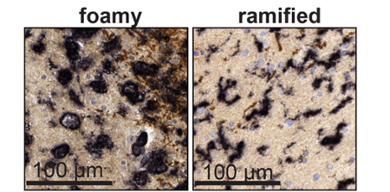
‘To truly understand the brain, we must understand the chemistry’
How do fats and enzymes in the brain contribute to multiple sclerosis? In his PhD research, Daan van der Vliet combined chemistry and neuroscience to gain new insights into how brain disorders develop.
Thanks to his work at the Leiden Institute of Chemistry and close collaboration with the Netherlands Institute for Neuroscience and the Dutch Brain Bank, Van der Vliet had access to brain tissue from deceased MS and Alzheimer’s patients. This made it possible to study these diseases at the molecular level.
The role of fats in MS
The research group of Mario van der Stelt focuses on fat-like signalling molecules (lipids) and their role in diseases such as cancer, Alzheimer’s and MS. Scientists have long suspected that lipids influence the course of MS, but lipids are difficult to study: you cannot see them under a microscope, and they are hard to manipulate directly.
The enzymes that regulate lipids, however, do offer opportunities. Van der Vliet developed chemical methods to study these enzymes. He used activity-based protein profiling, which allows scientists to measure the activity of groups of enzymes at the same time. He also created fluorescent labels that bind to specific enzymes, making them visible in brain tissue from both mice and humans.
What makes Van der Vliet’s work notable is that he designed, produced and applied the molecules he needed himself. ‘As a researcher you are usually involved in only one of those stages,’ he says.

‘Foamy’ microglia speed up disease progression
Van der Vliet discovered that the brain’s immune cells, the microglia, play a surprisingly large role in MS. In some patients, these microglia were filled with fat droplets. These so-called foamy microglia turned out to be strongly linked to faster disease progression and more damage. Working with the Brain Bank allowed him to demonstrate this connection directly in human brain tissue.
He also identified enzymes that influence fat metabolism in foamy microglia. ‘A pharmaceutical company we collaborated with already had an interest in one of those enzymes. Our study gave them a clear starting point for new medicines.’ Compounds that inhibit this enzyme are now in phase 1 clinical trials. ‘It is remarkable to be so close to the practical impact of your work,’ says Van der Vliet.
‘I felt like a spider in a web, connecting everything into one whole.’
Piecing together data and collaborations
His biggest challenge was bringing together data and expertise from many collaborations – with pharmaceutical companies, the Brain Bank, and various research groups in Amsterdam, Leiden and Utrecht. ‘I felt like a spider in a web, connecting everything into one whole.’
The partnership with the Dutch Brain Bank was essential. ‘Without donor material, you cannot properly study brain diseases. Animal models are useful for testing medicines, but not for understanding underlying disease processes.’ Working with brain tissue was a special experience, he adds. ‘The first time you hold a human brain in your hands is deeply moving.’
‘The brain is pure chemistry. To truly understand it, we must understand the chemistry. And every medicine that exists, or will be designed in the future, is chemistry.’
A next step in psychiatry
Van der Vliet now works as a postdoctoral researcher in the Psychiatry Department at Erasmus MC. ‘The combination of chemistry and brain diseases is so meaningful to me that I wanted to continue in this direction. We know even less about psychiatric disorders, and effective treatments are scarce.’
According to Van der Vliet, chemistry is indispensable in brain research. ‘The brain is pure chemistry. To truly understand it, we must understand the chemistry. And every medicine that exists, or will be designed in the future, is chemistry.’
Daan van der Vliet defended his thesis A chemical biology approach to explore lipid metabolism in neurological disorders on 24 June 2025 in the Academy Building. His supervisors were Mario van der Stelt and Inge Huitinga.
